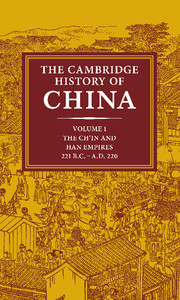Book contents
- Frontmatter
- Introduction
- 1 The state and empire of Ch'in
- 2 The Former Han dynasty
- 3 Wang Mang, the restoration of the Han dynasty, and Later Han
- 4 The conduct of government and the issues at stake A.D. 57–167
- 5 The fall of Han
- 6 Han foreign relations
- 7 The structure and practice of government
- 8 The institutions of Later Han
- 9 Ch'in and Han law
- 10 The economic and social history of Former Han
- 11 The economic and social history of Later Han
- 12 The religious and intellectual background
- 13 The concept of sovereignty
- 14 The development of the Confucian schools
- 15 Confucian, Legalist, and Taoist thought in Later Han
- 16 Philosophy and religion from Han to Sui
- Bibliography
- Glossary-Index
- Map 7 The Han empire, 143 b.c.
- Map 8 The Han empire, 108 b.c
- Map 9 The Han empire, a.d. 2
- Map 12 The Han empire, a.d. 140">
- References
1 - The state and empire of Ch'in
Published online by Cambridge University Press: 28 March 2008
- Frontmatter
- Introduction
- 1 The state and empire of Ch'in
- 2 The Former Han dynasty
- 3 Wang Mang, the restoration of the Han dynasty, and Later Han
- 4 The conduct of government and the issues at stake A.D. 57–167
- 5 The fall of Han
- 6 Han foreign relations
- 7 The structure and practice of government
- 8 The institutions of Later Han
- 9 Ch'in and Han law
- 10 The economic and social history of Former Han
- 11 The economic and social history of Later Han
- 12 The religious and intellectual background
- 13 The concept of sovereignty
- 14 The development of the Confucian schools
- 15 Confucian, Legalist, and Taoist thought in Later Han
- 16 Philosophy and religion from Han to Sui
- Bibliography
- Glossary-Index
- Map 7 The Han empire, 143 b.c.
- Map 8 The Han empire, 108 b.c
- Map 9 The Han empire, a.d. 2
- Map 12 The Han empire, a.d. 140">
- References
Summary
Ch'in long existed as a small state or principality and then, very briefly, as a major dynasty and empire. Its genesis as a state goes back to the traditional date of 897 B.C., but half a millennium had to pass before it really began its march toward universal rule around the middle of the fourth century. By contrast, the Ch'in dynasty and empire lasted only fifteen years before being cut short in 206 by civil wars from which arose the subsequent Han dynasty (206 B.C.–A.D. 220). Yet so vital were the political and cultural changes of these years that they gave the epoch an importance out of all proportion to its brevity.
The year 221 B.C., which marks the shift from state to empire, is consequently by far the most important single date in Chinese history before the revolutionary changes of the present century. Illustrative of the fame of the empire even beyond the Chinese world is the strong probability that the name Ch'in is the ancestor of “China” and other cognate designations in various non-Chinese languages. “Thinai” and “Sinai,” for example, appear as names of the country in Greek and Roman writings of the first and second century A.D. The Chinese themselves, however, always resented the Ch'in empire because of the harshness with which it achieved its rule, and therefore only very rarely used the name to refer to themselves; their common designation for themselves was and is the Central Country (chung-kuo).
- Type
- Chapter
- Information
- The Cambridge History of China , pp. 20 - 102Publisher: Cambridge University PressPrint publication year: 1986
References
- 25
- Cited by



